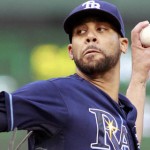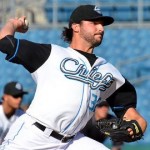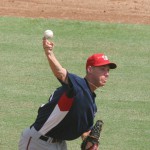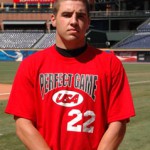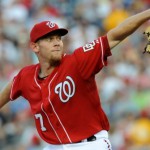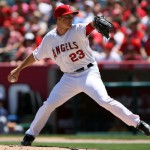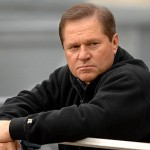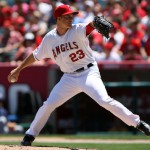Nothing like a Bill Ladson inbox to start off your week! This one is dated 10/4/13 and was posted late friday. As always I write my response here before reading his and edit questions for clarity and conciseness. Here we go.
Q: This past season, Adam LaRoche had a .403 slugging percentage, which might fly at shortstop, but not at first base. Do you think that Tyler Moore is good enough to be in a platoon with LaRoche, or should the Nats go after someone like James Loney to start most of the time?
A: Adam LaRoche‘s season was a disappointment for sure. In addition to the noted poor slugging percentage, I’ll give you two more interesting stats. He posted a bWAR of 0.9 for the year, which is only slightly better than the bWAR of 0.7 posted by Billy Hamilton during his two weeks of base-running terror in September. And he ranked 20th of qualified first basemen in the league in terms of fWAR for the year. James Loney put himself in a position to get a decent contract this year, with a nice slash line, a 118 OPS+ and a 7.2 UZR/150 at first. But Loney’s problem is that he just doesn’t hit for enough power. The Nats need LaRoche’s power, and I think at this point they stick with what they have for one more year and hope he rebounds. I don’t think Tyler Moore is ready for prime time and will continue to be a power RH bat off the bench. Lastly; who is taking LaRoche off our hands if we decide to replace him? We’d have to pay most of his salary, get little in return, and I just don’t see this management team doing that. Ladson agrees.
Q: How does Ross Ohlendorf fit in with the Nationals’ future plans? I see him as a great No. 4 or 5 starter.
A: Ross Ohlendorf is in an interesting spot. He was signed as a MLFA this past off-season, but did not accrue enough service time to get to 5 full years, so I believe he’s still tied to the club. He should be arbitration eligible, and (per springfieldFan’s big board work) seems to have 2 options left. So, on the one hand he pitched pretty well for us and I’d definitely tender him a contract for 2014; he’ll be relatively cheap even through arbitration. I see him competing for the 4th/5th with the other obvious candidates (Karns, Jordan, Detwiler, Roark), but his longer term history as a starter in 2011 and 2012 does not inspire confidence. His new motion helped him to a 3-1 record with a 3.52 ERA in 7 starts this year, but ultimately I see him settling into a long-man role similar to what he had this year. Ladson agrees; he’s arb eligible but doesn’t seem like he can stick as a starter.
Q: I feel like the Nationals should go after center fielder Jacoby Ellsbury. How do you feel about that?
A: Nope. Jacoby Ellsbury is a nice player, but I feel like he’s somewhat of a one-season wonder. Look at his career homer records and tell me how he hit 32 in 2011 when he’s never hit more than 9 in any other season?? Doesn’t that outlier scream out PEDs? Plus he can’t stay healthy; he missed 30 games this year, half of last year, basically all of 2010. He’s a Scott Boras client who is already making noise about getting more for Ellsbury than he got for Carl Crawford. Would you pay $150M for 7 years of Ellsbury??
But here’s the other thing; as with LaRoche, this team has a center fielder under contract for 2014! If the Nats want to make a change in center they’ll be selling somewhat low on Denard Span. Personally I wouldn’t mind putting Harper in center, acquiring a big bopper for left and adding some muscle to this lineup. But I just don’t see Mike Rizzo doing that and admitting defeat on the Span acquisition. Ladson points out that Span’s great finish means he’s clearly not in line to be replaced; organizationally they have to be hopeful that his 2014 will resemble more closely the end of 2013, not the middle. Fair enough; I can get on that bandwagon.
Q: Have you noticed how similar the home run swings of Wilson Ramos and Andres Galarraga are? Every time Ramos goes yard, he reminds me of The Big Cat.
A: I had not noticed, but sure, whatever. No real question here otherwise. I like Ramos, and he’s finally showing signs of durability after an injury-plagued career. This is the kind of hard-hitting question that Ladson is known for taking.
Q: Do you think the Nationals should go after another pitcher or two during the free agency period?
A: I think the Dan Haren experience may have scared them off the FA market for a bit. And this coming off-season’s FA market for Starting Pitching is really thin. After spending $13M each of the last two years for Haren and Edwin Jackson (and getting bWARs of -0.1 and 2.0 respectively) the Nats have to be thinking that there’s better ways to spend money. I wouldn’t be surprised in the least to see another deal similar to the Gio Gonzalez deal, where we package a slew of close-to-the-majors players together for one decent-to-good pitcher. The problem would be finding such a team; Oakland’s current slate of young starters mostly struggled this year and none of them are arb-eligible yet. Maybe Tampa lines up; not only do they have to deal with David Price‘s rising salary but Jeremy Hellickson is arb-eligible for the first time too. Hellickson took a major step back though in 2013; would Tampa use this to their advantage and keep him at a lower arb-number for one more year instead of selling low? Would you trade, say, Karns, Roark and Kobernus for Hellickson? Too much? Too little? Ladson says he could see them going after a pitcher either on FA or in Trade.
Q: Will Jhonatan Solano be the backup catcher out of Spring Training or will the Nationals try to bring in someone else?
A: This is one of the bigger questions for this team this coming off-season: do the Nats go into 2014 with Ramos and a minor league call-up as his backup, or do they go for a veteran backup? I’m guessing they may go the veteran FA route; there’s a ton of catchers on the FA market this year. Jhonatan Solano may have peaked as a player: his AAA slashline as a 27 yr old this year was .214/.245/.279. He’s been bouncing between AA and AAA since 2009. Sandy Leon seemed like he was the future answer, but he bottomed out this year too after looking great in 2012. I’d go with a veteran backup (Kurt Suzuki is a FA …) and wait out the kids one more season. Ladson thinks FA route.
Q: Do you think a new manager will be able to change the hitting philosophy of the team and play more small ball instead of over-swinging and trying for home runs all of the time?
A: Is that the perception of this team’s offense in 2013? That they over-swing all the time? I think they just don’t hit well in the clutch. Small-ball is a century old concept mostly debunked by modern stats in the game as being out-dated strategy. Honestly, I want a manager who stands up for his players, who keeps them in line, who isn’t afraid to order a bean-ball when it is called for, and who doesn’t come across as a feeble old man (sorry Davey Johnson; that’s how I interpreted your last season). Ladson says the hitting has settled since the firing of Rick Eckstein and the hiring of Rick Schu.
Q: I think that left-hander David Price would be the ideal arm to add to the Nationals’ rotation. If he is willing to agree to an extension, do you think that he would be a good fit for the Nationals?
A: Price would be a great fit on every team in the majors. Duh. The problem is extracting him from Tampa. Tampa is shrewd, drives a hard bargain, and wants to win every trade. They’re not exactly the best team to try to negotiate with. We’ve had this argument on this site many times; what would it really take to get Price out of Tampa? Giolito, Jordan, Kobernus and Rendon maybe? Would you make that deal or is that too much?
Of course, that being said … ask yourself this; was starting pitching *really* the reason this team failed in 2013? No I don’t think it was. Yes, the team was 10-19 in Haren’s starts … even if they’d finished .500 in Haren’s starts they were still out of the WC game. No; this team took a significant step backwards offensively. So the way to fix that should be to address the offense. Problem is; all 8 starting fielders are under contract or under team control for 2014. What do you do? Get a couple of bench guys who can hit? How does that help?
Ladson punts with his patented ‘lets see what happens’ line.
